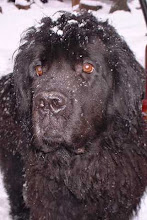"Beaucoup de Chien" is pidgin French for "a whole lot of dog",
The Newfoundland is a large, usually black, breed of dog originally used as a working dog in Newfoundland. They are known for their sweet dispositions. They are very loyal to their families and possess natural water rescue tendencies.
Appearance
Newfoundlands ("Newfies") have webbed feet and a water-resistant coat. Males weigh 60–70 kg (130–150 lb), and females 45–55 kg (100–120 lb), placing them in the "giant" weight range.
Most Newfies are black, but brown, gray (very rare), Irish Spotted (black with white markings), and Landseer (black head, white body with black markings) varieties exist. The Landseer is named after the artist Sir Edwin Landseer, who featured them in many of his paintings.Temperament
Newfies have a gentle, placid disposition. They are nicknamed the "Gentle Giant" and "Nature's babysitter." Indeed, the official AKC breed description says "Sweetness of temperament is the hallmark of the Newfoundland; this is the most important single characteristic of the breed." They are protective of children. The dog Nana in James M. Barrie's Peter Pan was a Newfoundland. (Newfie owners resent the depiction of her as a St. Bernard in the Disney animated film version; the 2004 film Finding Neverland used a Great Pyrenees).
The Newfoundland is smart and loyal. The breed is easily trained as they are eager to please their masters. They are neither easily frightened nor excitable. Relative to other breeds, Newfoundland puppies, especially older puppies, tend to be calm. Puppyhood doesn't last for extended amounts of time as in some breeds. They get along wonderfully with other dogs. They have deep, fierce-sounding barks, but are not good guard dogs. They have been known to grieve when separated from their families. Despite their wonderful qualities, this breed is not for everyone. Their large size makes them difficult to keep in many living situations, although they do not require great amounts of exercise and as puppies they tend to tire easily.
History
The origin of the breed is in Newfoundland on the East coast of Canada. In the early 1880s fishermen from many parts of Europe travelled to the cod banks of Newfoundland were there were two types of working dog: one more heavily built, large with a longish coat, whereas the other was lighter in build, an active, smooth-coated water dog. The heavier one was the Newfoundland and the other was the Labrador or the St. Johns breed of Newfoundland. The dogs were used in similar ways to pull fishnets and heavy equipment.
Health
The health problems associated with Newfoundlands. Newfoundlands are prone to Hip dysplasia (a malformed ball and socket in the hip joint), Elbow dysplasia, sub-aortic stenosis (a heart condition) and cystinuria (a hereditary defect that forms calculi stones in the bladder). When you buy one make sure the parents have
- a heart certificate (checked by using doppler)
- a cystinuria certificate(that both are not carriers and neither of them is sick)
Quotes
"The man they had got now was a jolly, light-hearted, thick-headed sort of a chap, with about as much sensitiveness in him as there might be in a Newfoundland puppy. You might look daggers at him for an hour and he would not notice it, and it would not trouble him if he did." Jerome K. Jerome Three Men in a Boat
"Near this spot are deposited the remains of one who possessed Beauty without Vanity, Strength without Insolence, Courage without Ferocity, and all the Virtues of Man, without his Vices. This Praise, which would be unmeaning Flattery if inscribed over human ashes, is but a just tribute to the Memory of Boatswain, a Dog." George Gordon, Lord Byron about his newfoundland.
"Newfoundland dogs are good to save children from drowning, but you must have a pond of water handy and a child, or else there will be no profit in boarding a Newfoundland." Josh Billings



No comments:
Post a Comment